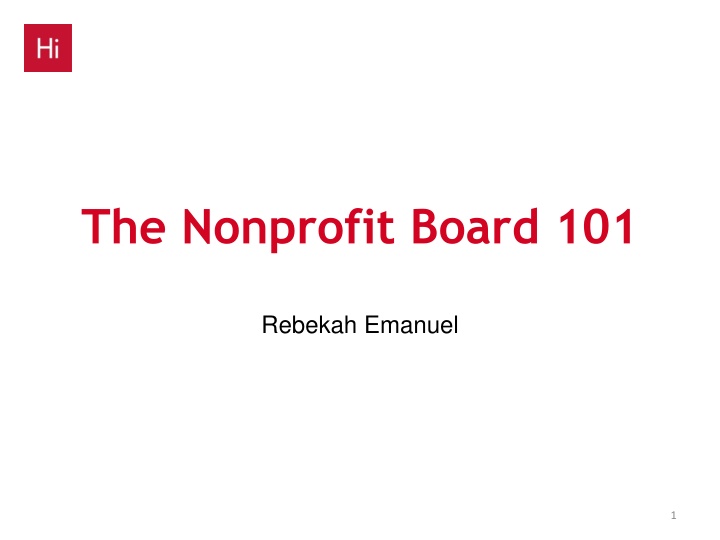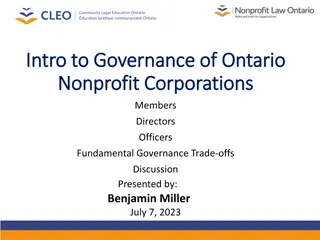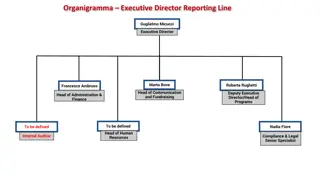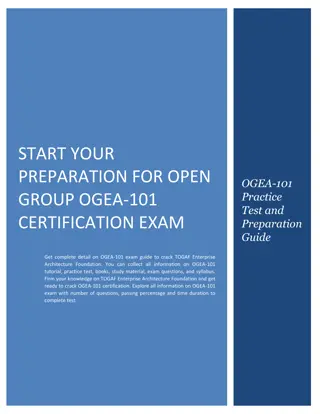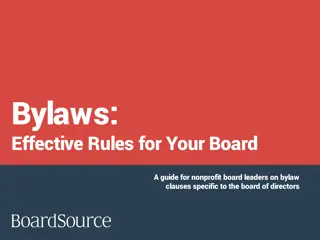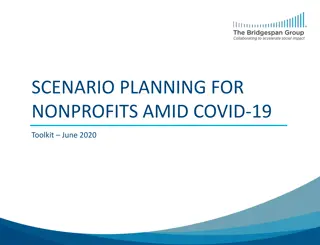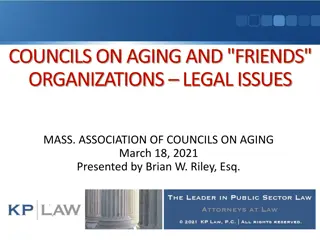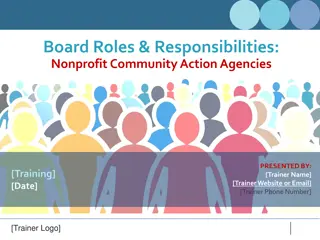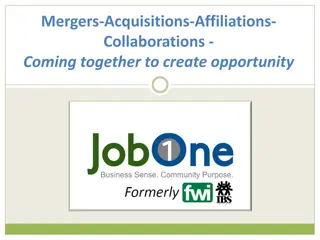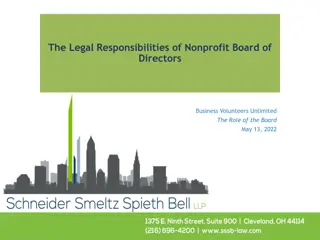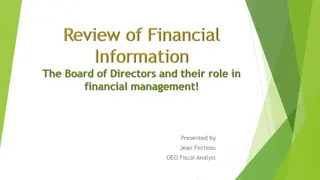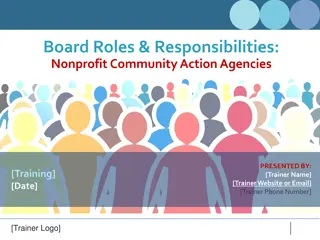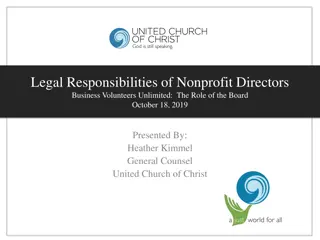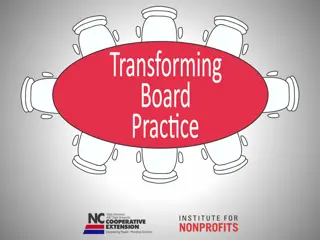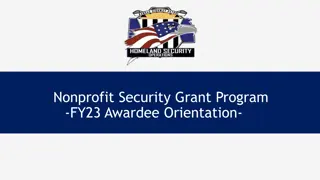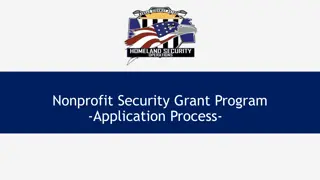The Nonprofit Board 101
Explore the essential roles and responsibilities of nonprofit boards, including governing and advisory roles, financial management, decision-making processes, and committee structures. Learn how to effectively create and run a successful nonprofit board to enhance organizational governance.
Download Presentation

Please find below an Image/Link to download the presentation.
The content on the website is provided AS IS for your information and personal use only. It may not be sold, licensed, or shared on other websites without obtaining consent from the author.If you encounter any issues during the download, it is possible that the publisher has removed the file from their server.
You are allowed to download the files provided on this website for personal or commercial use, subject to the condition that they are used lawfully. All files are the property of their respective owners.
The content on the website is provided AS IS for your information and personal use only. It may not be sold, licensed, or shared on other websites without obtaining consent from the author.
E N D
Presentation Transcript
The Nonprofit Board 101 Rebekah Emanuel 1
Tips for the Workshop In the chat tell us Your venture name For {users} who have {problem} we {what you do} What stage you are at in creating a board for your nonprofit 2
Agenda What does a board DO? Key roles Structure Adding people to your board Who? How many? How? How to run a board Focus on discussion and decisions (not read outs) Use people s strengths Regular cadence of decisions 3
Lets be clear what we are talking about Governing Board (Board of Directors) Advisory Board Roles Approve Budgets Hire/Fire the CEO Board members fiscally liable Roles Advises top team if asked on a particular topic Lends name to the organization Requirements Meets quarterly, sits on committees Requirements Informally expected to reply if team reaches out with a question 5
What a Governing Board Does Official Roles Financial Management Governance In a non-profit, the Board is also often a Fundraising engine Source of potent social networks Source of credibility Approve Budgets Oversee Audits Hire/Fire the CEO Review the CEO Nominate board members Clarify how board makes decisions 6
How a Board Works Full Board Meets quarterly Votes on official decisions Common Standing Committees: Finance Committee Meet quarterly Dig into content and vote to make formal recommendations to the board Plus: Audit Development Committee Governance Committee Nominating Committee Committee Topical Committee Each board may also have standing committees on specific topics Ad-hoc committees on particular topics of interest meet only as needed, and then are disbanded Strategic Planning 7
Size and Composition Full Board Size: Roles: 1 Chair 1 Vice Chair Secretary, Treasurer CEO usually attends all meetings but steps away for executive session (usually a period at the end of a meeting with only board members and no staff) Often non voting but this can vary Top team (CFO, COO etc) often join to present the part of the agenda that is topically relevant Usually an odd number (avoiding tied votes) Commonly 3-17 8
Size and Composition Committees Size: Board members rarely have capacity to sit on more than 1-2 committees at a time Committee chair roles take up more bandwidth Roles: 1 Chair (Often do not have other roles) Usually staffed by relevant staff member E.g. CFO staffs the finance and audit committees Pick the board members with most expertise + 1 set of fresh eyes to ask zoom out questions 9
Cadence Committees Finance usually reviews the annual budget proposal in at the end of the discal year and recommends a vote to the full board Audit reviews audit results once per year Governance conducts CEO review and feedback usually once per year, reviews board performance, sets board and committee charters Nominations ensures a regular cadence of recommending and reviewing new members Development opens doors for fundraising, spearheads board member giving, helps propel the annual fundraising cycles (E.g. for individual giving, this is usually a big push in Nov/Dec, so board members need tools before then) 10
Who? Time Talent Treasure 12
How Many Set your overall size goal Set how long Common term limits of 2-3 years Sometimes renewals allows indefinitely, others capped (wide range of what's common, 10 years) You want a clear not awkward off ramp if its not working Add people in groups Attend to board culture and bondedness Can on- and off- board as part of mini cohorts 13
How? The Process Get a few great people first Set the bar high Common to start friends and family and then professionalize Funders often ultimately look for a professional board Add people to fulfill specific skill gaps on the board 14
How? The Cultivation Get to know someone first, don t ask in your first meeting Ask them for advice on an issue in their area Observe Do they make time? How useful are they? Do they listen? Do they add value? If added to the board they will Set your budget Hire/fire CEO Get a sense for how they work on these things Cultivate the relationship for a little bit before inviting them 15
Debate, dont Update Ok so you have great people and quarterly meetings, now what? In Meetings Mark sections as FYI FYI (very few), Discussion Discussion, or Decision Decision FYI: Don t make meetings about updates (it s deadly boring AND not using people s skill sets) Send out a read ahead deck (powerpoint, not word document) 1-2 weeks ahead of time Expect people to pre-read it Open each section by asking if there were any questions about it, don t recap (or you let people off the hook for pre-reading) Discussion: In the meeting, frame a few (1-2) meaty topics for discussion For some discussions you will just want people s insights but want to still make the decision yourself later. Decision: A formal vote For many discussions you may want to come to a decision and have board approval (eg a budget, an expansion) Decisions need an official vote Figuring out which decisions require a formal board vote is key 17
Who Decides What? Which decisions require a formal board vote? Which are management decisions ? Be sure everyone agrees on the answers! Some things are clear: Board: Approve budget and any major deviations from budget, Hire/Fire CEO, Review Audit, Make large strategic decisions Management: Manage staff, Make daily operational decisions, Make financial decisions within budget/below a threshold In between: Incremental strategic decisions, key operational decisions, tricky top team decisions Consider consulting but not asking for a formal recommendation or vote 18
How to Vote Ok so you have agreement, how do you get a formal board vote Here are the steps Specific proposal One person makes a formal proposal be clear on the specifics Ideally written in the deck or a board member says it and someone records it) 1stperson: A board member moves that the proposal be approved I move that xxx be approved 2nd person: A second board member seconds it I second it All vote Board chair (or someone else) says all in favor say Aye/Yes, all against say Nay/No all abstaining say abstain Or on zoom ask people to put it in the chat Someone records and tallies the votes Some things may need different levels of agreement to pass, depending on the board rules you set Write it down The results should be recorded in the minutes 19
Agenda Pre-Read Deck Supplements a monthly short CEO-letter Operational updates and progress on key metrics Framing 1-2 meaty topics Some will be seasonal (eg budget) The other quarters use for key strategic discussions and decisions No surprises (make sure key updates and decisions are shared regularly and incrementally) In the meeting Allocate most of the time to the discussion 20
Where? Ideally in-person If you are all over the world Most board meetings held remotely (1-3 hours) 1x/year in person (meeting plus social time) 21
How to Use The Board? Focus on the core reason for having a board Getting the big picture view Zooming out from daily operations Tapping into expertise and networks Think about each person and ask if you are using their strengths People are most invested when they feel useful but not over tapped Make sure you are using their unique magic 22
Questions? 23
How Can We Make This Most Practical For You? Tell Us How The Session Was: https://www.surveymonkey.com/r/M8KNHQQ 24
